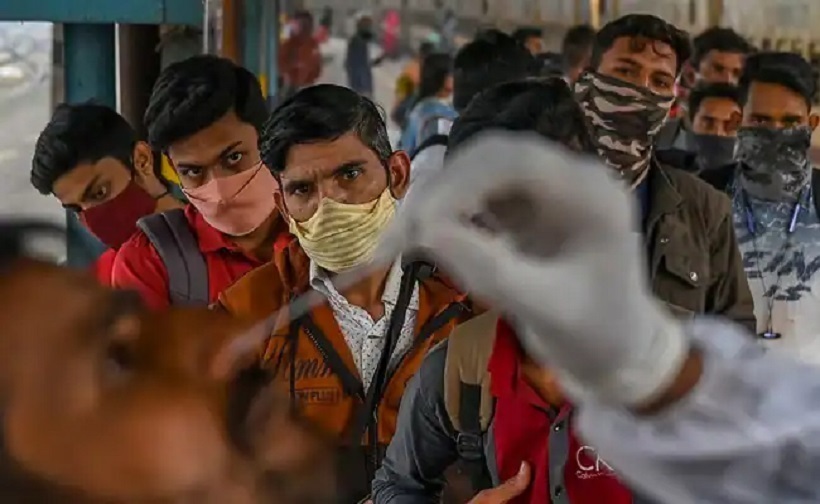
Kolkata- Blanket approaches such as complete restriction on the movement of people and travel bans can be counterproductive in containing Covid in a country like India, says WHO’s India representative Roderico H Ofrin while advocating target, risk-based strategies to counter the pandemic.
Stressing on the need to protect both lives and livelihoods, he said public health action in India and across the world must be continually guided by evidence from four key questions — how transmissible is the variant, severity of the disease it causes, how well vaccines and prior SARS-CoV-2 infection protect and how common people perceive risk and follow control measures.
“WHO does not recommend a blanket travel ban, nor complete restriction of people’s movement. In many ways, such blanket approaches can be counterproductive. India with its diversity in population distribution and geographic spread, the risk-based approach remains the wiser public health practice to counter a pandemic,” Ofrin told news agency PTI in an email interview.
Depending on the epidemiological situation, available public health capacities and social and economic context, governments should tailor their measures to prevent and control the transmission, the Delhi-based official said as an Omicron driven surge pushed India’s Covid tally to 3,76,18,271 (37.6 million/3.76 crore) on Tuesday.
“WHO advises governments to adopt nuanced, targeted and risk-based approaches which involve layered control measures, reducing the risks associated with travel and transmission,” Ofrin said.
If all the dos and don’ts are followed, there is no need for lockdowns.
“In the current scenario, existing tools and solutions continue to be effective — expanding vaccination coverage, using masks, maintaining hand hygiene, physical distancing, ventilation of indoor spaces and crowd avoidance help in cutting the chain of transmission. If these are followed, there will be no need for lockdowns,” Ofrin maintained.
He said the emergence of the new variant of coronavirus in this magnitude “has been beyond expectation” and it is evident “Omicron has a growth advantage over Delta spreading rapidly across states and territories”.
The country reported 2,38,018 new coronavirus infections, according to the Union Health Ministry on Tuesday. With this, active cases have increased to 17,36,628 (1.7 million/17.3 lakh), the highest in 230 days, while the death count has climbed to 4,86,761 with 310 fresh fatalities.
Though it is not possible to undertake genome sequencing of every sample, experts are agreed the current wave is largely being driven by the Omicron variant.
Elaborating on ways to handle the current Covid situation, Ofrin, who joined as WHO’s India Representative in July 2020, stressed that it is not just the responsibility of the government but also of every individual.
“This is the same virus/disease with a different variant. The mitigation measures put forth against earlier variants are still recommended to combat Omicron. Strategies to test, trace and treat along with strengthening surveillance and health systems; expanding vaccination coverage, maintaining essential health services, and community-level containment measures effectively underpin response efforts to combat the pandemic,” he added.
On whether the Centre was late in deciding to administer booster doses to doctors, and other healthcare and frontline workers, the WHO India head said, “WHO’s main recommendation continues to be to prioritise access to vaccines for vulnerable populations and those who have not yet completed their doses, and deployment of boosters is secondary. This has also been India’s vaccination strategy.
“Boosters as per recommendation of the WHO Strategic Advisory Group of Experts (SAGE) remains for those who are immunocompromised, those with chronic diseases especially the elderly.”
Implementing a blanket booster programme while large segments of the population remain unvaccinated is likely to prolong the pandemic and misses the larger population that it aims to protect, Ofrin explained.
Vaccination for children should be introduced after a proper study on the safety of children keeping in mind India’s epidemiological and social context, he said.
“Although a majority of COVID-19 vaccines are only approved for use in adults aged 18 years and above, an increasing number of vaccines are also being authorised for use in children now. Only after evidence on safety for children is well studied and deliberated as per the country’s epidemiological and social context, can a vaccine be introduced for this age group,” he said.
“India is already vaccinating the 15-18 years age group. The National Technical Advisory Group on Immunisation (NTAGI) and National Expert Group on Vaccine Administration of COVID-19 (NEGVAC) are deliberating and considering scientific evidence related to the justification of vaccines to children below 15 years,” he added.
Discussing WHO’s role in helping the Centre combat the pandemic, Ofrin said it has been providing technical and on-ground support through it network of 2,600 field officers and personnel based in 23 states and also reaching out all states and union territories (UTs).
“Our people deployed across programmes including immunisation, tuberculosis, neglected tropical diseases etc. have been repurposed to work with health authorities at all levels to respond to the pandemic,” he said.
Will 2022 see the current pandemic coming to an end?
“It is very difficult to put a date on the end of the pandemic. Do remember that as the virus keeps transmitting, there is a chance for new variants to appear which can be more transmissible or severe. It is possible to bring this virus under control by ensuring availability and strategic use of the tools we have.” Ofrin replied.
Follow this link to join our WhatsApp group: Join Now
Be Part of Quality Journalism |
Quality journalism takes a lot of time, money and hard work to produce and despite all the hardships we still do it. Our reporters and editors are working overtime in Kashmir and beyond to cover what you care about, break big stories, and expose injustices that can change lives. Today more people are reading Kashmir Observer than ever, but only a handful are paying while advertising revenues are falling fast. |
| ACT NOW |
| MONTHLY | Rs 100 | |
| YEARLY | Rs 1000 | |
| LIFETIME | Rs 10000 | |













